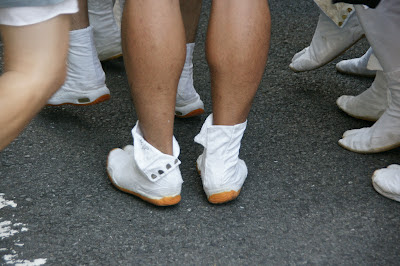Last weekend I had the opportunity to get up-close and personal with the matsuri (festival) of a quiet Tokyo neighborhood, thanks to one of my lovely colleagues, Kyoko, who extended an invitation to her home and a chance to be involved in carrying the mikoshi through the streets to the local temple.
Having seen the physical exertion involved with this particular ritual, I opted for the shutter-bug route, but two of our new-to-Tokyo friends were brave enough to give it a try. Lindsey and Brendan got garbed up in their linen clothes and donned their borrowed happi coats. The coats are particular to each neighborhood, so Kyoko's husband, no stranger to the annual event, had borrowed some extras. The carriers also traditionally wear soft white boots that have a split toe.
This yearly festival is a chance for the neighborhood to come together and honor the god of the area shrine, so the 'portable' shrines are carried from their usual resting places to the larger shrine in the area. Along the way, they pause to show respect to shrines or businesses that have been generous donors through the years.
People change places as they get tired, and a small entourage follows the process. There are a few rest stops along the way, where saw-horses appear from nowhere to hold the mikoshi's weight for awhile as the tired, sweaty carriers grab a drink from the trays that also appear as if by magic. When ready to move again, the guy with the wooden blocks is hoisted up and gives a few sharp, ringing claps to alert everyone that it's time to carry on.
Upon reaching the shrine, the team is blessed and takes a rest break under the beautiful trees as families meander through the stalls set up with games to play and food for sale. Then, rest break over, they retrace their steps back through the streets.
You can check out the complete gallery here!

























